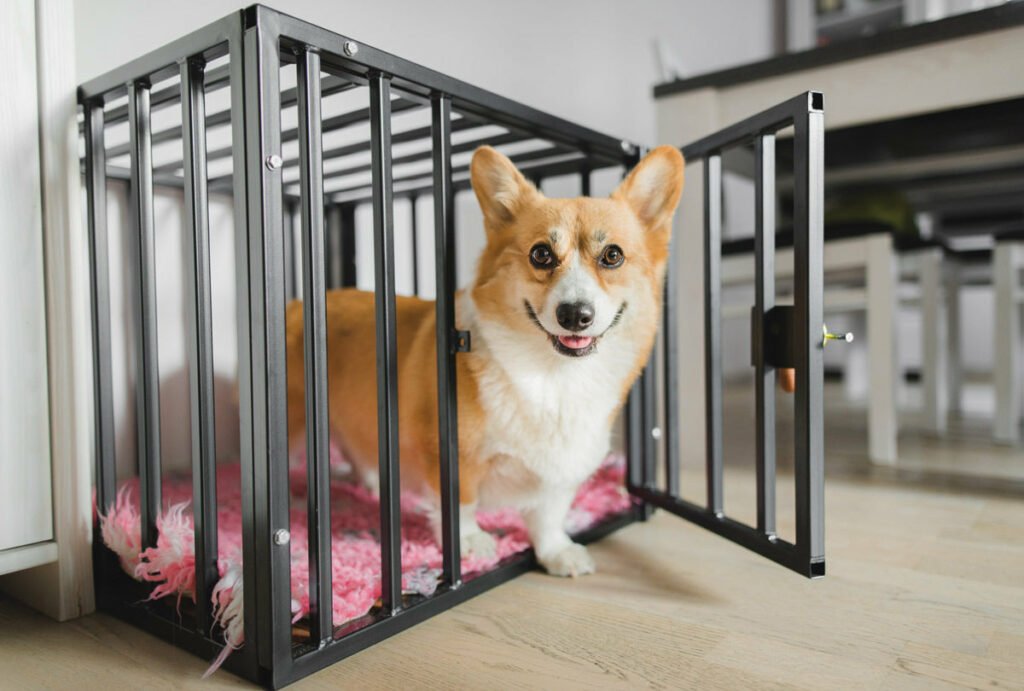Table of Contents
Crate training your puppy at night can be a smooth and stress-free process with the right approach. It helps establish a routine, ensures safety, and aids in housebreaking. This guide provides essential tips on how to crate train a puppy at night, ensuring a restful night for both you and your furry friend.

1. Choose the Right Crate
Selecting the appropriate crate is crucial for successful crate training:
- Size Matters: Choose a crate large enough for your puppy to stand, turn around, and lie down comfortably.
- Comfortable Bedding: Add a soft bed or blanket to make the crate cozy.
- Ventilation: Ensure the crate has good ventilation to keep your puppy comfortable.
2. Create a Positive Association
Make the crate a positive and inviting space for your puppy:
- Introduce Gradually: Allow your puppy to explore the crate with the door open, using treats to create a positive association.
- Feed Inside: Feed your puppy their meals inside the crate to reinforce positive feelings.
- Use Toys: Place your puppy’s favorite toys inside the crate to encourage them to spend time there.
3. Establish a Bedtime Routine
A consistent bedtime routine helps your puppy understand when it’s time to sleep:
- Set a Schedule: Establish a regular bedtime to create predictability.
- Calm Activities: Engage in calming activities like a gentle play session or a short walk before bedtime.
- Bathroom Break: Ensure your puppy has a bathroom break just before bedtime to reduce nighttime wake-ups.
4. Gradually Increase Crate Time
Build up the time your puppy spends in the crate gradually:
- Start Small: Begin with short periods, gradually increasing the duration as your puppy becomes more comfortable.
- Stay Nearby: Initially, stay close to reassure your puppy, gradually increasing the distance as they adjust.
- Use Positive Reinforcement: Reward your puppy with treats and praise for staying calm and quiet in the crate.
5. Manage Nighttime Wake-Ups
Handling nighttime wake-ups properly is essential for effective crate training:
- Stay Calm: If your puppy wakes up, stay calm and avoid making it a playtime.
- Bathroom Breaks: Take your puppy for a quick bathroom break if needed, then return them to the crate.
- Minimal Interaction: Keep interactions brief and quiet to reinforce that nighttime is for sleeping.
6. Be Patient and Consistent
Patience and consistency are key to successful crate training:
- Stick to the Routine: Maintain a consistent bedtime routine and crate training schedule.
- Handle Setbacks Calmly: If setbacks occur, stay calm and continue with the training plan.
- Avoid Negative Associations: Never use the crate as a punishment, as this can create negative associations.
7. Provide Comfort and Security
Ensure your puppy feels safe and secure in the crate:
- Comfort Items: Include familiar items like a blanket or a piece of clothing with your scent.
- Calm Environment: Keep the crate in a quiet, low-traffic area to minimize distractions.
- Nightlight: Consider using a nightlight if your puppy seems anxious in the dark.
Conclusion on How to Crate Train a Puppy at Night
Successfully crate training a puppy at night involves choosing the right crate, creating positive associations, establishing a bedtime routine, gradually increasing crate time, managing nighttime wake-ups, being patient and consistent, and providing comfort and security. By following these tips, you can ensure a smooth and stress-free experience for both you and your puppy. For more information on puppy training and care, visit the ASPCA and AKC.
FAQs on How to Crate Train a Puppy at Night
How long does it take to crate train a puppy at night?
The time it takes varies depending on your puppy’s age, breed, and personality. Consistent training typically yields results within a few weeks.
What if my puppy cries in the crate at night?
If your puppy cries, stay calm and avoid letting them out immediately. Wait for them to calm down before opening the crate to avoid reinforcing the crying behavior.
Should I cover my puppy’s crate at night?
Covering the crate can create a den-like environment that helps your puppy feel secure. Ensure adequate ventilation and observe your puppy’s reaction to see if they find it comforting.
Can I use the crate for daytime training as well?
Yes, using the crate for short periods during the day can reinforce positive associations and help with overall training.
Is it okay to let my puppy sleep in my bedroom?
Having the crate in your bedroom can help your puppy feel more secure and allow you to respond to nighttime needs quickly. Gradually move the crate to the desired location once they are comfortable.
What should I do if my puppy has an accident in the crate?
If an accident occurs, clean the crate thoroughly to remove any odors. Ensure your puppy has had ample opportunities for bathroom breaks and adjust the nighttime routine if necessary.











